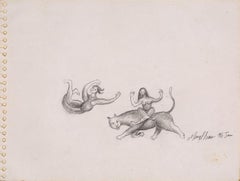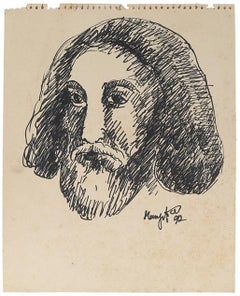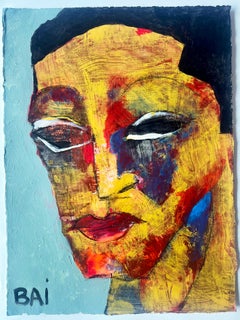Manjit Bawa Art
to
1
1
Overall Width
to
Overall Height
to
2
2
2
1
1
2
2
1
1
1
2
1
1
1
1
2
8,816
2,808
1,655
1,313
Artist: Manjit Bawa
Animal, Women, Graphite on Paper, Pasted on Board by Modern Artist "In Stock"
By Manjit Bawa
Located in Kolkata, West Bengal
Manjit Bawa - Untitled - 6 x 8 inches (unframed size)
Graphite on Paper & Pasted on Board.
About the Artist 7 his works :
Born : July 30, 1941, Dhuri, Punjab.
Died : December 29, 2008 New Delhi.
Education :
1958-63 Studied at the School of Art, Delhi Polytechnic, New Delhi
Exhibitions :
Selected Posthumous Exhibitions
2013-14 'Transition', 20th Anniversary Show, Centre of International Modern Art (CIMA), Kolkata
2013 'Ideas of the Sublime', presented by Vadehra Art Gallery at Lalit Kala Akademi, New Delhi
2013 'The Sahmat Collective: Art and Activism in India since 1989', Smart Museum of Art at University of Chicago, Chicago
2012 'Art for Humanity', Coomaraswamy Hall, Chhatrapati Shivaji Maharaj Vastu Sangrahalaya, Mumbai
2012 'Contemporary: A Selection of Modern and Contemporary Art', prsented by Sakshi Gallery at The Park, Chennai
2012 'Crossings: Time Unfolded, Part 2', Kiran Nadar Museum of Art (KNMA), New Delhi
2011 'The Path of the Lotus: Indian Art', Grosvenor Gallery, London
2011 'Lets Paint the Sky Red', India Habitat Centre and Vadehra Art Gallery, New Delhi
2011 'Anecdotes', Sakshi Gallery, Mumbai
2011 'High-Light', presented by Sakshi Gallery, Mumbai at The Oberoi, Gurgaon
2011 'Time Unfolded', Kiran Nadar Museum of Art (KNMA), New Delhi
2011 'Roots in the Air, Branches Below: Modern & Contemporary Art from India...
Category
1990s Contemporary Manjit Bawa Art
Materials
Board, Graphite, Paper
Self Portrait, Drawing, Pen & Ink on Paper by Modern Indian Artist "In Stock"
By Manjit Bawa
Located in Kolkata, West Bengal
Manjit Bawa - Self Portrait - 14.75 x 10.75 inches (unframed size)
Pen & Ink on Paper.
About the Artist 7 his works :
Born : July 30, 1941, Dhuri, Punjab.
Died : December 29, 2008 New Delhi.
Education :
1958-63 Studied at the School of Art, Delhi Polytechnic, New Delhi
Exhibitions :
Selected Posthumous Exhibitions
2013-14 'Transition', 20th Anniversary Show, Centre of International Modern Art (CIMA), Kolkata
2013 'Ideas of the Sublime', presented by Vadehra Art Gallery at Lalit Kala Akademi, New Delhi
2013 'The Sahmat Collective: Art and Activism in India since 1989', Smart Museum of Art at University of Chicago, Chicago
2012 'Art for Humanity', Coomaraswamy Hall, Chhatrapati Shivaji Maharaj Vastu Sangrahalaya, Mumbai
2012 'Contemporary: A Selection of Modern and Contemporary Art', prsented by Sakshi Gallery at The Park, Chennai
2012 'Crossings: Time Unfolded, Part 2', Kiran Nadar Museum of Art (KNMA), New Delhi
2011 'The Path of the Lotus: Indian Art', Grosvenor Gallery, London
2011 'Lets Paint the Sky Red', India Habitat Centre and Vadehra Art Gallery, New Delhi
2011 'Anecdotes', Sakshi Gallery, Mumbai
2011 'High-Light', presented by Sakshi Gallery, Mumbai at The Oberoi, Gurgaon
2011 'Time Unfolded', Kiran Nadar Museum of Art (KNMA), New Delhi
2011 'Roots in the Air, Branches Below: Modern & Contemporary Art from India...
Category
1990s Contemporary Manjit Bawa Art
Materials
Paper, Ink, Pen
Related Items
Contemporary Surreal Cartoon Pen & Ink Drawing on Canvas by British Artist
Located in Preston, GB
Contemporary Surreal Cartoon Pen & Ink Drawing on Canvas entitled 'Green Man' by Contemporary British Artist. A rainbow of colours emerges from the earth, as man reaches forward. Symbolic visionary art from creative drawings, meditations & psychedelic visions in the late 1990's.
Art measures 16 x 12 inches
Frame measures 21 x 17 inches
Fil Earthstomp is an enigmatic artist and musician from deep in the subculture of England. Born in 1976, he produced mainly drawings in the 1990's, leading to electronic musical compositions and video installations...
Category
Early 2000s Contemporary Manjit Bawa Art
Materials
Ink, Permanent Marker, Felt Pen, Acrylic, Canvas
$10,958 Sale Price
60% Off
H 16 in W 20 in D 3 in
Ornette by African American Artist Bai, Colorful Work on Paper
By Bai (Carl Karni-Bain)
Located in New york, NY
A muted color acrylic and oil pastel of an androgenous subject with Modigliani eyes, Ornette by African American artist Bai is an enigmatic portrait made on 15” x 11” etching paper. ...
Category
2010s Contemporary Manjit Bawa Art
Materials
Acrylic, Oil Pastel, Rag Paper, Ballpoint Pen
$1,200
H 15 in W 11 in D 0.25 in
Figurative Ink Painting N.1 'Vessels' by Dmitry Samygin
By Dmitry Samygin
Located in Paris, FR
Figurative Ink on Cotton paper
Painting N.1 'Vessels' by Dmitry Samygin
H.27 x 19.5 cm
About Dmitry Samygin
Furniture and Product Designer. His approach relies on simple forms and clarity in ideas with carefully chosen materials to expose the essence of an object. His products exemplify humanistic design, comfort in everyday use and ergonomic function.
He is a prize-winner in international competitions. He has taken part in exhibitions in Paris, Milan and Moscow, collaborates with European and Russian production, architectural and design companies. Since 2021 Dmitriy's design has been presented in a permanent exhibition at the Museum of Arts and Crafts in Moscow. Dmitry's graphics and designs are in private collections all over the world.
Samygin's Awards
2023 I+D / Design Now / winner (product design & decor)
2021 Red dot / Modul
2021 I+D magazine award / Shelter (covers for the sculptures of Moscow State Architectural Museum)
2020 Best 2020 AD Russia
2019 Andrew World...
Category
21st Century and Contemporary Contemporary Manjit Bawa Art
Materials
Cotton, Paper, Ink
$711
H 10.63 in W 7.68 in D 0.04 in
Figurative Ink Painting N.2 'Vessels II' by Dmitry Samygin
By Dmitry Samygin
Located in Paris, FR
Figurative Ink on Cotton paper
Painting N.1 'Vessels II' by Dmitry Samygin
H.27 x 19.5 cm
About Dmitry Samygin
Furniture and Product Designer. His approach relies on simple forms and clarity in ideas with carefully chosen materials to expose the essence of an object. His products exemplify humanistic design, comfort in everyday use and ergonomic function.
He is a prize-winner in international competitions. He has taken part in exhibitions in Paris, Milan and Moscow, collaborates with European and Russian production, architectural and design companies. Since 2021 Dmitriy's design has been presented in a permanent exhibition at the Museum of Arts and Crafts in Moscow. Dmitry's graphics and designs are in private collections all over the world.
Samygin's Awards
2023 I+D / Design Now / winner (product design & decor)
2021 Red dot / Modul
2021 I+D magazine award / Shelter (covers for the sculptures of Moscow State Architectural Museum)
2020 Best 2020 AD Russia
2019 Andrew World...
Category
21st Century and Contemporary Contemporary Manjit Bawa Art
Materials
Cotton, Paper, Ink
$711
H 10.63 in W 7.68 in D 0.04 in
Circus Rider, Acrobat
By Simka Simkhovitch
Located in Greenwich, CT
Simkhovitch was a celebrated artist in New York City from the 1920's through the 1940's. Life Magazine did a story on him and he was having great success in the New York Galleries. ...
Category
1920s American Realist Manjit Bawa Art
Materials
Paper, Graphite
Puissance, Horse Drawing, Charcoal and graphite on Fabriano paper, white frame
By Patsy McArthur
Located in Dallas, TX
Puissance is a beautiful and unique charcoal drawing on paper of a dynamic horse. The Fabriano paper is a high quality watercolor grade set in a custom white wood frame, all archival...
Category
2010s Realist Manjit Bawa Art
Materials
Charcoal, Archival Paper, Graphite
$3,900
H 34.65 in W 39.38 in D 1.58 in
A Pair of Framed Monkey Studies
By Alexander Oscar Levy
Located in Buffalo, NY
A pair of exquisite drawings by American Ashcan School artist Alexander Oscar Levy.
Category
1920s Ashcan School Manjit Bawa Art
Materials
Archival Paper, Graphite
Roots - Contemporary Figurative Ink, Ecolina Painting, New Expression
Located in Salzburg, AT
Grażyna Rigall is a painter, illustrator, author of stage designs and music videos. - The artist is interested in the merging of the world of fauna and flora with the world of man, p...
Category
2010s Contemporary Manjit Bawa Art
Materials
Paper, Ink, Watercolor
$829
H 18.9 in W 14.18 in
"Things are Looking Up" Charcoal Drawing
Located in Denver, CO
Tammy Liu-Haller's "Things are Looking Up" is an original, handmade charcoal and graphite drawing that depicts a fox in profile looking upwards towards the s...
Category
2010s Photorealist Manjit Bawa Art
Materials
Charcoal, Archival Paper, Graphite
Umbilical Filigree Ovum (drawing)
By Hunter Stabler
Located in Philadelphia, PA
This is an original India ink, graphite, chalk, and pen on paper drawing by Hunter Stabler measuring 14.25”h x 20.25”w framed. The piece ships in the pictured frame.
Hunter Stable...
Category
21st Century and Contemporary Contemporary Manjit Bawa Art
Materials
Paper, Chalk, India Ink, Ballpoint Pen, Graphite
Surrealist Painting Royal College Art LGBTQ+ Female Fun Fair Pink Horse Banana
By Isabel Rock
Located in Norfolk, GB
Isabel Rock is a creator of contemporary fairy tales. A graduate of the Royal College of Art in London, her work is an explosion of strange occurrences while a surreal narrative takes the audience on a journey into the imagination.
In October 2023 Isabel won the Evelyn Williams Drawing Award at the Trinity Buoy Wharf Drawing Prize. Known as the UK’s most prestigious annual open exhibition for drawing; part of the prize is a solo show at Hastings Contemporary, scheduled for 2024.
Whilst Isabel always has a tale to tell for each of her images, you may or may not choose to go on the journey with her or you may indeed have a different story, one of your own that jumps off the page at you, that that you decide to follow.
Artwork Details:
(D), 50x40cm, acrylic ink and acrylic paint on paper, 2011
Artwork Provenance: from the Artist Studio
A certificate of authentication comes from Gallery Art 1821...
Category
2010s Contemporary Manjit Bawa Art
Materials
Paint, Mixed Media, Acrylic, Archival Paper, Pen
$1,301
H 19.69 in W 15.75 in
"Edge Event XXVII", Figurative, Graphite, Drawing, Canvas, Horses, Realism
By Joseph Piccillo
Located in St. Louis, MO
Joseph Piccillo’s meticulous charcoal and graphite drawings and paintings reveal an exquisite draftsmanship tempered by emotional sensitivity. Piccillo presents an action-based assem...
Category
1980s Contemporary Manjit Bawa Art
Materials
Canvas, Charcoal, Graphite
$12,500
H 45 in W 60 in D 1 in
Manjit Bawa art for sale on 1stDibs.
Find a wide variety of authentic Manjit Bawa art available for sale on 1stDibs. You can also browse by medium to find art by Manjit Bawa in paper, board, graphite and more. Much of the original work by this artist or collective was created during the 1990s and is mostly associated with the contemporary style. Not every interior allows for large Manjit Bawa art, so small editions measuring 16 inches across are available. Customers who are interested in this artist might also find the work of Chandra Bhattacharya, Prasanta Sahu, and Debabrata Basu. Manjit Bawa art prices can differ depending upon medium, time period and other attributes. On 1stDibs, the price for these items starts at $5,661 and tops out at $7,720, while the average work can sell for $6,691.



